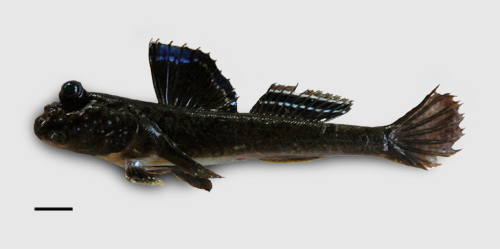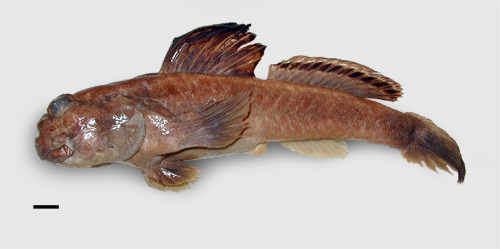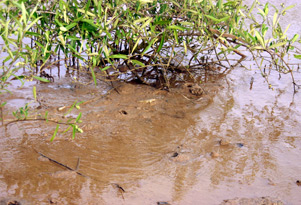|
Common names:
Benin |
Fon GBE |
Tokouintokouin |
China |
Chinese Mandarin |
奇弹涂鱼, 奇彈塗魚, 大西洋弹涂鱼, 大西洋彈塗魚 (Qi tan tu yu, Da xi yang tan tu yu - Weird Mudskipper, Atlantic Mudskipper) |
Cote d'Ivoire |
Adioukrou |
Edrekodou |
Cote d'Ivoire |
Aizi |
Nokonan |
Cote d'Ivoire |
Akan |
Sori-sori |
Denmark |
Danish |
Afrikansk dyndspringer |
France |
French |
Sauteur de vase atlantique |
Germany |
German |
Schmetterlings-Schlammspringer |
Ghana |
Adangme |
Adi |
Ghana |
Akan |
Mprabedi, Pitsir, Soetsi, Sosobedzi |
Ghana |
Efik |
Mbume |
Ghana |
Ewe |
Atramedekakpui |
Ghana |
Ga |
Lomole, Putumpuli |
Ghana |
Nzema |
Sakrobonto |
Italy |
Italian |
perioftalmo atlantico* |
Mauritania |
French |
Périophthalme |
Poland |
Polish |
Poskoczek mulowy |
Portugal |
Portuguese |
Saltão-da-vasa |
Sierra Leone |
English |
Jumbo fish |
Spain |
Spanish |
Saltafango atlántico |
United Kingdom |
English |
Atlantic mudskipper |
* proposed name
|

Periophthalmus barbarus. Kribi, Cameroon, Africa; lateral view;
the bar is 10 mm long - freshly dead specimen
(photo: R.E. Brummett, 2007, with permission)

Periophthalmus barbarus. Morocco, Africa; lateral view;
the bar is 10 mm long - specimen fixed in formalin and preserved in ethanol
(LACM 54540: Lat 30N, Long 10W, 1969; photo: R. Feeney, 2008, with permission)
|
|
Synonyms:
|
Gobius barbarus |
Linnaeus, 1766 |
(senior syn., original combination)** |
|
Periophthalmus barbarus |
(Linnaeus, 1766) |
(senior syn., new combination) |
|
Gobius koelreuteri |
Pallas, 1770 |
(junior synonym)** |
|
Periophthalmus koelreuteri |
(Pallas, 1770) |
(junior synonym, new combination)** |
|
Periophthalmus papilio |
Bloch & Schneider, 1801 |
(junior synonym) |
|
Periophthalmus erythronemus |
Guichenot, 1858* |
(junior synonym) |
|
Periophthalmus papillon |
Duméril, 1861 |
(mispelling for P. papilio) |
|
Periophthalmus gabonicus |
Duméril, 1861 |
(junior synonym) |
|
Periophthalmus erythronotus |
Rochebrune, 1882 |
(mispelling for erythronemus) |
*In: Duméril, 1861
**sensu Murdy (1989)
Etymology:
'Periophthalmus' is a compound name from the Greek 'peri' (around), and 'ophthalmôn' (eye), which refers to the wide visual field of these species
'barbarus' in Latin means 'strange', 'foreign', probably referring to the amphibious habits of mudskippers
|
Maximum recorded length:
250 mm SL (Harrison & Miller, 1992)
Live colouration
(based on the available photos and drawings: pers. obs.:
Cameroon):
background colour dark brown to greyish on head, dorsum and flanks, ventrally whitish; sky blue speckles on flanks, which are larger and more numerous on snout, cheeks and opercula; several black to dark brown irregular saddle-like diagonal bars may be visible on dorsum. D1 membrane dark brown, with a black to bluish inframarginal band, sandwiched by a narrow and broken whitish-blue stripe and a narrow transparent margin; D1 completely black in some specimens; D2 background brown, with a medial black stripe sandwiched by two white stripes, and a brown margin; caudal fin dusky, with series of dark brown speckles along rays in some specimens;
anal fin from whitish to brownish with a yellowish margin; pelvic fins dark brown on dorsal side; pectoral fins dusky
Colouration on preservation
(Murdy, 1989; pers. obs.: Cameroon, Nigeria):
background colour dorsally and laterally dark grey to brown, ventrally yellowish; dark irregular blotches and remnants of diagonal bars may be visible on head and body. D1 membrane dark brown, with a black inframarginal band, sandwiched by a narrow and broken pale stripe and a very narrow transparent margin; in some specimens, few white spots basally on the posterior portion of D1; D2 background brown, with a medial black stripe sandwiched by two white stripes, and a brown margin; caudal fin dusky, with series of dark brown speckles along rays in some specimens;
anal fin dusky; pelvic fins pigmented on dorsal side; pectoral fins dusky
Diagnosis (Murdy, 1989):
D1 X-XIV; total D2 elements 11-14; total anal fin elements 9-11; longitudinal scale count 86-107; TRDB 20-34; pelvic fins without frenum and completely separated (no basal membrane); D1 margin straight; dorsal fins not connected by membrane; colouration pattern of D1 and D2.
The genus is yet undefined by synapomorphies
Diet:
omnivore: algae, macrophytes, arthropods (mainly insects and sesarmid crabs), nematodes, bivalves, fish. P. barbarus forage more actively during the dry season, which is also the breeding season (King & Udo, 1998)
|
|
Reproduction:
in Nigeria, a study of the monthly variation of the gonadosomatic index showed that P. barbarus spawns once a year from February to May. These fishes matured at approx. 10-11 cm TL; they reached a maximum estimated length of about 22 cm TL, and a maximum life span of 6 yr. The breeding season coincides with the end of the dry season/beginning of the rainy season. In this way, during the wet season, the fry stand takes advantage of the higher productivity of the estuary, stimulated by the larger fluvial suspended loads. Accordingly, there is only one recruitment pulse per year (Etim et al., 1996; 2002; King & Udo, 1997a)
|
|
|
|
Ecological notes:
in Nigeria, P. barbarus is found in mangrove and Nypah palm forests (King & Udo, 1997b).
This species is largely consumed and used as bait in Nigeria (probably at an unsustainable
level: Etim et al., 2002), and it was considered
for large scale farming (Fineman-Kalio & Alfred-Okciya, 1989).
P. barbarus was also included among the endangered fish species of Nigeria
(Egborge, 1993), due to
the high level of environmental degradation of coastal systems
middle: typical habitat of P. barbarus (photo: J. Baker, Guinea Bissau, 2007,
Flickr)
|
|
|
|
Distribution (Murdy, 1989, museum collections: pers. obs., LACM 54540):
recorded from Morocco to Angola; type locality (neotype): Liberia
|
|
|
Remarks:
Together with Boleophthalmus pectinirostris, Periophthalmus barbarus is one of the two Linnean oxudercine gobies.
The short Latin description of Gobius barbarus by Linnaeus (1766),
is not much informative ("pinnis pectoralibus flabello insistentibus; pinna dorsi prima radiorum 12, secunda 13"); nonetheless, it is identical to the first part of a detailed description of a Periophthalmus sp. by Koelreuter
(1763), who nonetheless did not
designate a binomial taxon; both Koelreuter and Linnaeus did not report any type locality.
Subsequently, Pallas
(1770) described three oxudercine species: Gobius boddarti, G. schlosseri, and G. koelreuteri; for this latter one, also Pallas (1770) did not indicate any
type locality. After him, Gmelin (1789) reported a brief version of this description in the 13th edition of the Systema Naturae.
Bloch and Schneider (1801) designated
the genus Periophthalmus, based on P. papilio Bloch and Schneider n. sp., which had "hand-like" pectoral fins and "eyelids" ("Pinnae pectorales manuformes, oculi palpebrati"), and included three more species in this genus: P. koelreuteri (Pallas), P. schlosseri (Pallas), and P. ruber
Bloch and Schneider (which will be later considered as a junior synonym of Pn. schlosseri (Pallas) by several authors; see Remarks on
Pn. schlosseri). Bloch and Schneider
(1801) indicated Tranquebar, India, as the type locality
of P. papilio (hence of the genus Periophthalmus). Nonetheless, the illustration of P. papilio
(see drawing below) clearly depicts the only and endemic west African Periophthalmus sp. [= P. barbarus (Linnaeus) sensu Murdy (1989)].
Later on, Lesson (1831) described P. kalolo. Then Cuvier and Valenciénnes (1837) redescribed P. koelreuteri (Pallas) on the basis of several specimens from the Red Sea, the coasts of East Africa, western and eastern India, New Ireland, Indonesia, New Guinea, and Oceania.
In a rather drastic revision, Günther (1861) further revised P. koelreuteri (Pallas), synonymising it with G. barbarus on the basis of the very short description by Linnaeus (1766), and treating P. kalolo Lesson, P. argentilineatus Cuv. and Val., P. dipus Bleeker, P. modestus Cantor, and P. papilio Bloch & Schneider as races of P. koelreuteri. Day (1889) and Jordan & Seale (1906) followed Günther (1861).
Eggert (1935), strongly objecting Günther (1861), restored all the species that Günther synonymised, further subdividing some of them in different races, and in particular: 1) recognised P. kalolo Lesson as a subspecies of P. koelreuteri (Pallas) (see also Remarks in P. kalolo), and 2) showed that G. barbarus Linnaeus was inconsistent with the description of P. koelreuteri (Pallas).
More recently, Murdy (1989) argued that 1) the detailed description by Koelreuter (1763); 2) the very short description of G. barbarus
Linnaeus (which he assumed to be just an abstract of the Koelreuter's one); 3) the description of G. koelreuteri Pallas; and 4) that one of P. papilio Bloch and Schneider (all
lacking both reliable type localities and type specimens), are all consistent with the only Atlantic species of the genus Periophthalmus. Therefore, Murdy (1989) synonymised
G. koelreuteri (hence P. koelreuteri), G. barbarus and P. papilio as Periophthalmus barbarus (Linnaeus), and designated a neotype from Liberia
(AMNH 32777). Then, he designated P. kalolo Lesson as a valid species, and the subspecies of P. koelreuteri described by Eggert (1935) as junior synonyms of P. kalolo Lesson.
Nonetheless, the drawings and the description by Koelreuter (1763;
see drawing below) clearly depicted the presence of partially fused pelvic fins ("... intimorum quidem radiorum bases, membrane tenuissimae et angustissimae ope, cohaerent, ..."), a trait that is inconsistent with the Atlantic Periophthalmus sp. Furthermore, as noticed also by Eggert (1935), Linnaeus (1766) wrote that all the species included in his 'family Gobius' (thus including G. barbarus), had fused pelvic fins ("... pinnae ventrales unitae in ovatum"). Even Bloch & Schneider (1801) left G. barbarus in the genus Gobius, which in this work is characterised by the presence of fused pelvic fins ("Pinnae ventrales concretae, basi cavum efformantes").
On the other hand, the description of G. koelreuteri Pallas (1770) clearly reports the presence of separated pelvic fins ["... P. ventralis in duas partita (unico exemplo in genere Gobiorum )";
see also the drawing below]. Surprisingly, when Bloch & Schneider (1801) reported the description of P. koelreuteri (Pallas), they described the fins as connected basally ["(pinnis) ventralibus basi connexis"]. It is therefore probable that neither Pallas (1770) based his description of P. koelreuteri on the material examined by Koelreuter (1763), nor Bloch & Schneider (1801) based their description on the material examined by Pallas (1770). The original description by Pallas (1770) of G. koelreuteri has priority over the description of P. koelreuteri (Pallas) by Bloch & Schneider (1801), and all its subsequent redescriptions. Nonetheless, it is my opinion that the hypothesis that the Linnean description corresponds to the Atlantic mudskipper is rather questionable.
In this rather confused scenario, several congeneric species were discriminated as either P. koelreuteri (e.g. Day, 1889) or P. barbarus (e.g. Herre, 1927), especially those ones with wider
geographical distributions (see also Remarks in P. kalolo).
|
Photographs of Periophthalmus barbarus:
|
|
A: P. barbarus from Príncipe I., Democratic Republic of São Tomé and Príncipe (photo: D. Lin; Island Biodiversity Race, 2008);
B: two specimens from The Gambia (photo: B.C. Tørrissen, Tenda-Ba, The Gambia, 2007;
One for the Road , 2008)*; C: another specimen from The Gambia (photo: S. Robinson, Yundum, The Gambia, 2007;
Flickr, 2008)*; D-G: P. barbarus in aquarium
(photo D: S. Williams, Newport, Cincinnati, 2008; Flickr, 2008*;
photo E: T. Mukai;
Mukai's Encyclopedia of Gobies, 2008*; photo F: M. Tanabe;
Marli's mudskipperland, 2008; photo
G: anonimous); H: ventral view of a specimen in aquarium (photo: M. Tanabe;
Marli's mudskipperland, 2008) - *
with permission
|
Drawings of Periophthalmus barbarus:
A: cephalic sensory and nasal pores of Periophthalmus spp.: an = anterior nostril; pn = posterior nostril
(modified from Murdy, 1989)*; B: Periophthalmus barbarus (Pallas)
(Bianchi, 1986); C: Periophthalmus barbarus (Pallas)
(Poll, 1959, in
Harrison and Miller, 1992); D: Periophthalmus papilio Bloch & Schneider
(Bloch and Schneider, 1801): note the bluish pigmentation in D1 and the morphology
of the pelvic fins; E: Periophthalmus papilio
Bloch & Schneider (Cuvier and Valenciénnes, 1837);
F: Gobius koelreuteri Pallas (Pallas, 1770);
G: unnamed (Koelreuter, 1763): note the state of the pelvic fins (see Remarks) - * with permission
|






![]()